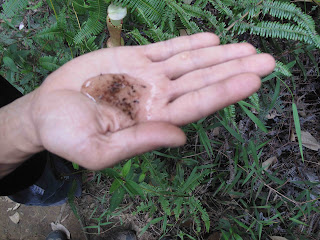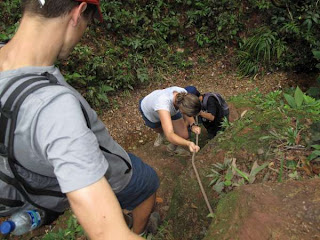Penang
We touched down in Malaysia aboard our first propeller plane of the trip. And while we were a bit skeptical about the flight worthiness of the vessel, as evident by the Lindsay's sweaty palms, the flight proved to be remarkably smooth. We spent our first few days in Malaysia on the Island of Penang, which was home to a remarkably diverse range of cultures and cuisines. Established as a important trading post by the British during the 19th century, Penang is home to a significant population of Chinese, Indian and Malay peoples. And having arrived from Indonesia, whose more homogeneous cuisine had become a bit dull to us, we wasted no time gorging ourselves with more Pork Buns, Naan, and Dumplings than I care to recount.

Of course our visit to Penang did not revolve solely around eating. Between meals we strolled through the charming colonial streets of Penang, visiting several Chinese temples, a historical mansion and an impressively large chocolate store. (As an aside, we named this blog entry in honor of the tour guide who took us through the mansion in Penang. He was quite the character and concluded the tour with an apt piece of wisdom regarding Penang: "Prepare for ever-burgeoning waistlines.") And while the heat was oppressive at times, Penang proved to be one of the cooler cities we have visited on our adventure.


Another shot of Kek Lok Si Temple

Splittin' for a couple days
The very talented Lindsay preparing PB&J's while waiting for a bus

Sarah lapping in the warm waters of the Perhetian Islands...

Lindsay and I on the canopy walkway

Sweat residue from sitting down. Lindsay was sitting on the right.
"KL" as it is often called is the capital of Malaysia and is a large bustling metropolis that gave us a bit of a reminder of western life. Below is a photo of the signature skyscrapers in the city-the Petronas Towers, which were at one point the largest buildings in the world.
KL proved to be a good place to run some much needed errands. Mark and I (Lindsay) needed to get more passport pages, so we made a trip to the US embassy. Sarah mailed off her registration for the Bar exam and Chris got a haircut! We did the usual tourist stuff as well and paid a visit to the National Museum and explored Little India and Chinatown for more diverse culinary delights. Interesting tidbit-while KL gave us a taste of "western" life, including big malls, designer stores, fancy buildings, it was the first city of the trip in which we saw numerous women dressed in full burkas, so that only the eyes showed. The women wearing this garb would often be accompanied by men dressed in western style shorts and a t-shirt.
Last note-sadly it was in KL that the parasites part of this trip reared its ugly head. Sarah was the first of the four of us to get a stomach bug, which she appropriately named Elvira. Sarah was an incredible trooper and after a long couple weeks overcame Elvira, though this would not be the last time we would fall victim to stomach bugs. From KL the four of us hopped onto another plane to Vientiane, Laos. Sabaidee Laos!

KL's Petronas Towers

Getting a much needed Dosa fix








































